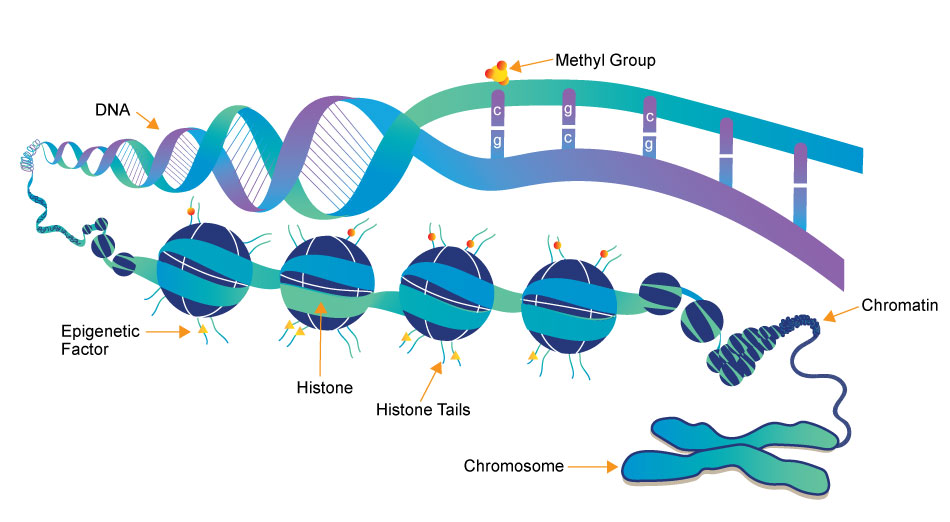Epigenetics


Epigenetics research delves into the molecular mechanisms that control gene expression and cellular traits without altering the underlying DNA sequence. One crucial aspect of this field is the role of small molecules, which act as powerful regulators of epigenetic modifications. These small compounds, typically comprising a few dozen to a few hundred atoms, have emerged as essential tools in understanding and manipulating the epigenome.
- DNA Methylation Inhibitors: Small molecules like 5-azacytidine and 5-aza-2'-deoxycytidine are DNA methyltransferase inhibitors. They block the addition of methyl groups to DNA, leading to DNA demethylation. This can reactivate silenced genes, potentially offering therapeutic avenues for conditions like cancer.
- HDAC inhibitors: HDACs remove acetyl groups from histone proteins, contributing to gene repression. Small molecule HDAC inhibitors, such as Vorinostat and Romidepsin, can reverse this process by increasing histone acetylation, allowing genes to be more accessible for transcription. These inhibitors are being explored for cancer therapy and other conditions.
- Histone Methyltransferase Inhibitors: Small molecules like GSK126 inhibit specific histone methyltransferases, affecting histone methylation patterns. This can alter gene expression, making them promising candidates for cancer and other diseases with epigenetic dysregulation.
- RNA Modulators: Small molecules can also target non-coding RNAs involved in epigenetic regulation. For instance, small molecules called small interfering RNAs (siRNAs) can be designed to target and degrade specific long non-coding RNAs, influencing gene expression.
- Epigenetic Reader Domain Inhibitors: These small molecules target proteins that recognize and bind to specific epigenetic marks. Examples include inhibitors of bromodomain-containing proteins (BET inhibitors), which can disrupt gene regulation by interfering with protein-DNA interactions.
Small molecules in epigenetics research not only provide insights into the fundamental biology of gene regulation but also hold immense promise for developing novel therapeutics. Their ability to selectively modulate specific epigenetic marks and pathways has led to ongoing clinical trials and drug development efforts for various diseases, including cancer, neurological disorders, and inflammatory conditions. Understanding and harnessing the power of these small molecules is at the forefront of modern epigenetics research, offering new hope for precision medicine and targeted therapies.
3 key components involved in the regulation of epigenetic modifications
Epigenetics Writer
Epigenetics writers are enzymes responsible for adding chemical marks or modifications to DNA or histone proteins. These marks include DNA methylation (addition of methyl groups to DNA) and histone modifications (such as acetylation, methylation, phosphorylation, etc.).
Epigenetics Reader
Function: Epigenetics readers are proteins that can recognize and bind to specific epigenetic marks on DNA or histones. These reader proteins interpret the epigenetic code and facilitate downstream cellular processes, such as gene activation or repression.
Epigenetics Eraser
Function: Epigenetics erasers are enzymes responsible for removing or reversing epigenetic marks on DNA or histones. This process allows for the dynamic regulation of gene expression and the resetting of epigenetic states during various stages of development and in response to environmental changes.
-
p53 activator
Tenovin-6 是 tenovin-1 的类似物。Tenovin-6 在体外抑制纯化的人类 SIRT1、SIRT2 和 SIRT3 的蛋白去乙酰化酶活性,其 IC50 值分别为 21、10 和 67 微摩尔。- Igase M,, .et al. , Exp Cell Res, 2019, Dec 28:111810 PMID: 31891684
-
p53 activator
JNJ-26854165 是一种 p53激活剂,并且与AraC或多柔比星协同作用,以诱导 p53介导的凋亡,可能为急性白血病的治疗提供一种新的治疗方法。- Chang SJ, .et al. , Arch Biochem Biophys, 2018, Jun 1;647:10-32 PMID: 29655550
-
p53 activator
RITA,也被称为 NSC 652287,是一种三环噻吩衍生物,它能够结合到 MDM2,打断 MDM2-p53 复合体,随后激活 p53 并诱导凋亡。- M Kobayashi, .et al. , Oncotarget, 2020, May 5;11(18):1653-1665 PMID: 32405340
-
p53 抑制剂
Pifithrin-beta 是一种小分子p53抑制剂。- J Priyanga, .et al. , Chem Biol Interact, 2020, Nov 1;331:109250 PMID: 32956706
-
p53 抑制剂
Pifithrin-α hydrobromide 是一种可逆的 p53 介导的凋亡和 p53 依赖的基因转录抑制剂,如 cyclin G、p21/waf1 和 mdm2 的表达。 -
p53-MDM2 interaction 抑制剂
p53 和 MDM2 蛋白相互作用抑制剂手性是一种抑制 p53 和 MDM2 蛋白之间相互作用的抑制剂。 -
p53-MDM2 interaction 抑制剂
p53 和 MDM2 蛋白相互作用抑制剂(外消旋体)是一种抑制 p53 和 MDM2 蛋白之间相互作用的抑制剂。 -
p53 stabilizer
CP 31398 二盐酸盐,p53稳定剂。稳定 p53 的活性构象,并在带有突变型或野生型 p53 的癌细胞系中促进 p53 活性。在体内抑制小型人类肿瘤异种移植物的生长。 -
p53 stabilizer
PhiKan 083,p53稳定剂;优先结合突变型(Y220C)p53而非野生型p53,结合位点与功能性DNA/蛋白质相互作用区域不同。 -
mutant p53 Reactivator
RETRA 盐酸盐是一种抗肿瘤药物,它能够在体外和体内通过依赖突变的 p53 和 p73 来抑制肿瘤细胞的生长。 -
MDMX 抑制剂
SJ 172550 是首个 MDMX 抑制剂,具有 0.84 uM 的 EC50;可逆性结合到 MDMX 上,并有效杀死 MDMX 表达增强的视网膜母细胞瘤细胞。- Saketh S Dinavahi, .et al. , Cancer Immunol Res, 2022, Jun 3;10(6):757-769 PMID: 35439317
-
HIF-1α 抑制剂
盐酸米诺环素是一种广谱四环素类抗生素,其作用机制是通过结合到细菌的30S核糖体亚基并抑制蛋白质合成。- Viktoria Lazar, .et al. , Nature, 2022, 610: 540-546 PMID: 36198788
- PhiKan 083 盐酸盐是一种咔唑衍生物,它能结合到表面腔体并稳定 Y220C(一种 p53 突变体),具有 Kd 为 167 μM,以及在 Ln229 细胞中的相对结合亲和力(Kd)为 150 μM。
-
antineoplastic agent
三聚氰胺三环氧化物(TGIC;Teroxirone)是一种具有抗血管生成和抗肿瘤活性的三嗪三环氧化物。




